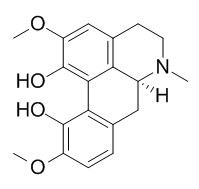Corytuberine
Corytuberine was inhibited only by naloxone and that of bulbocapnine preferentially by yohimbine.
Inquire / Order:
manager@chemfaces.com
Technical Inquiries:
service@chemfaces.com
Tel:
+86-27-84237783
Fax:
+86-27-84254680
Address:
1 Building, No. 83, CheCheng Rd., Wuhan Economic and Technological Development Zone, Wuhan, Hubei 430056, PRC
Providing storage is as stated on the product vial and the vial is kept tightly sealed, the product can be stored for up to
24 months(2-8C).
Wherever possible, you should prepare and use solutions on the same day. However, if you need to make up stock solutions in advance, we recommend that you store the solution as aliquots in tightly sealed vials at -20C. Generally, these will be useable for up to two weeks. Before use, and prior to opening the vial we recommend that you allow your product to equilibrate to room temperature for at least 1 hour.
Need more advice on solubility, usage and handling? Please email to: service@chemfaces.com
The packaging of the product may have turned upside down during transportation, resulting in the natural compounds adhering to the neck or cap of the vial. take the vial out of its packaging and gently shake to let the compounds fall to the bottom of the vial. for liquid products, centrifuge at 200-500 RPM to gather the liquid at the bottom of the vial. try to avoid loss or contamination during handling.
bioRxiv - Biochemistry2023, 548213.
Int J Pharm.2022, 618:121636.
Journal of Ginseng Research2022, j.jgr.2022.09.005.
Sustainable Chemistry & Pharmacy2022, 30:100883.
Eur J Pharmacol.2024, 978:176749.
J Chromatogr B Analyt Technol Biomed Life Sci.2018, 1080:27-36
Korean Herb. Med. Inf. 2016, 4(1):35-42
Sci Rep.2019, 9:19059
Regen Biomater.2023, 10:rbad077.
Molecules.2022, 27(7):2116.
Related and Featured Products
Arch Int Pharmacodyn Ther. 1988 Nov-Dec;296:255-81.
Neuroleptic-like, anticonvulsant and antinociceptive effects of aporphine alkaloids: bulbocapnine, corytuberine, boldine and glaucine.[Pubmed:
2907279]
METHODS AND RESULTS:
The aporphine alkaloids bulbocapnine, Corytuberine, boldine and glaucine were studied in mice and compared with haloperidol, phenobarbital and morphine. All aporphines inhibited the exploratory rearing activity and elicited palpebral ptosis, catalepsy, hypothermia, and prolonged anesthesia by thiopental. They also reduced nociception (hot plate; phenylquinone-induced writhing) and (except for Corytuberine) were anticonvulsant against harman and picrotoxin, but not against bicuculline and pentetrazol; Corytuberine was proconvulsant. The aporphines (except for Corytuberine) antagonized the apomorphine- and methylphenidate-induced stereotyped gnawing and also the apomorphine-induced climbing activity; Corytuberine was prostereotypic. The antignawing effects (including those of haloperidol) were stronger when the antagonists were administered after the agonists (gnawing full-fletched) rather than before them: this led to the speculation of a metaphilic interaction at central site(s). Clonazepam inhibited the antistereotypic effect (vs apomorphine) more potently with the aporphines than with haloperidol. The antinociceptive effect (writhing) of the aporphines was, in contrast to that of morphine, resistant to both naloxone and yohimbine. The latter applied also to the antilicking action in the hot plate test; the antijumping effect of boldine was (like that of morphine) antagonized by both yohimbine and naloxone, whereas that of Corytuberine was inhibited only by naloxone and that of bulbocapnine preferentially by yohimbine.
METHODS AND RESULTS:
Hence, opioid and adrenergic mechanisms are unequally involved in the antinociceptive effects of the aporphines. The present results also showed that licking and jumping (in the hot plate test) are pharmacologically different phenomena. In low doses, the aporphines and haloperidol antagonized the antinociceptive effect of morphine (hot plate); hence, these drugs may be considered partial agonists or partial antagonists, respectively.



